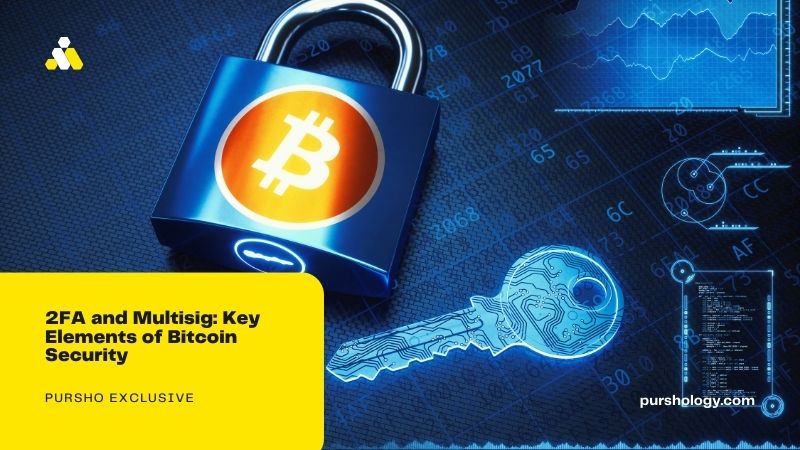Bitcoin’s meteoric rise in popularity has brought about a heightened need for security within the cryptocurrency world. With the promise of financial sovereignty and decentralized transactions, Bitcoin has also attracted the attention of cybercriminals looking to exploit any vulnerabilities in users’ security practices. In this article, we delve deep into two crucial elements of Bitcoin security: Two-Factor Authentication (2FA) and Multisignature (Multisig) wallets. These tools can significantly bolster the safety of your Bitcoin holdings. Want to learn more about Kaspa’s Blockchain? Then look at the clickable link here.
Understanding Two-Factor Authentication (2FA)
What is 2FA?
Two-Factor Authentication, commonly known as 2FA, is a security measure designed to ensure that only authorized individuals gain access to a system or account. It goes beyond the traditional username and password by requiring users to provide an additional piece of information, making it exponentially more challenging for unauthorized parties to access your Bitcoin holdings.
Importance of 2FA in Securing Bitcoin
The use of 2FA is especially crucial in the world of Bitcoin, where the loss of your private keys can result in irreversible financial consequences. By requiring a second factor of authentication beyond your private key, 2FA adds an extra layer of security that can protect your assets from theft or unauthorized access.
Different Types of 2FA
There are various methods to implement 2FA, each with its own strengths and weaknesses.
SMS-Based 2FA
SMS-based 2FA involves receiving a one-time code via text message that you must enter when logging in. While convenient, this method is susceptible to SIM swapping attacks, where an attacker convinces your mobile provider to transfer your phone number to a new SIM card.
Authenticator Apps
Authenticator apps like Google Authenticator and Authy generate time-sensitive codes that must be entered during login. These apps are more secure than SMS-based 2FA since they are not tied to your phone number.
Hardware Tokens
Hardware tokens are physical devices that generate authentication codes. These are the most secure 2FA method, as they are immune to both SIM swapping attacks and malware on your device.
Pros and Cons of 2FA
Enhanced Security vs. Potential Vulnerabilities
2FA significantly enhances security by adding an extra layer of authentication. However, it’s essential to remain cautious, as cybercriminals have found ways to compromise 2FA, such as through phishing attacks that trick users into providing their 2FA codes.
Real-World Examples of 2FA Breaches
Several high-profile incidents have highlighted the importance of robust 2FA implementation. Notable breaches have occurred in cryptocurrency exchanges, where users’ funds were stolen due to inadequate 2FA protection. Learning from these incidents is crucial to securing your own Bitcoin holdings.
Multisignature (Multisig) Wallets
What is Multisig?
Multisignature, or Multisig, is a technology that goes beyond traditional single-signature wallets by requiring multiple private keys to authorize a transaction. In a Multisig wallet, a predefined number of signatures are necessary to validate a transaction, making it inherently more secure.
How it Differs from Traditional Single-Signature Wallets
Traditional Bitcoin wallets operate with a single private key. If this key is compromised or lost, it can lead to a complete loss of funds. Multisig wallets, on the other hand, distribute responsibility across multiple keys, reducing the risk associated with a single point of failure.
Use Cases for Multisig
Protecting Against Single Points of Failure
One primary use case for Multisig is protecting against the loss or theft of a single private key. For example, a 2-of-3 Multisig wallet requires two out of three private keys to authorize a transaction, providing redundancy and security.
Escrow Services and Shared Control
Multisig wallets are also ideal for escrow services and shared control of funds. In scenarios where multiple parties need to agree on the release of funds, Multisig allows for secure and transparent transactions.
Implementing Multisig
Setting Up a Multisig Wallet
Creating a Multisig wallet involves generating multiple private keys and specifying the required number of signatures for each transaction. Wallet software and hardware options are available to facilitate this process.
Exploring Different Multisig Configurations
Multisig configurations vary in complexity, with options like 2-of-2, 2-of-3, 3-of-5, and more. Choosing the right configuration depends on your specific security needs and risk tolerance.
Comparing 2FA and Multisig
Strengths and Weaknesses of 2FA vs. Multisig
2FA and Multisig are both powerful tools for enhancing Bitcoin security, but they have distinct advantages and drawbacks. Understanding when to use each is essential.
When to Use 2FA and When to Opt for Multisig
The choice between 2FA and Multisig depends on your security goals and risk assessment. Combining both can provide maximum protection, but it’s crucial to understand the trade-offs.
Real-World Examples of Security Breaches
Examining real-world incidents where Bitcoin holders experienced security breaches highlights the importance of 2FA and Multisig. Analyzing these cases can help you make informed decisions about your security strategy.
Best Practices for Bitcoin Security
Combining 2FA and Multisig for Maximum Protection
To maximize Bitcoin security, consider using both 2FA and Multisig. This layered approach can significantly reduce the risk of unauthorized access and loss.
Securing the Devices and Platforms Used for Cryptocurrency Transactions
Protecting the devices and platforms you use for cryptocurrency transactions is essential. Keep your operating systems, wallets, and software up to date to mitigate vulnerabilities.
Regularly Updating Security Protocols
Cryptocurrency security is an ever-evolving field. Stay informed about the latest security developments and adapt your practices accordingly to stay one step ahead of potential threats.
Preparing for Contingencies and Disaster Recovery
Plan for contingencies by establishing backup procedures and recovery methods. Being prepared for the unexpected can safeguard your Bitcoin holdings.
Case Studies
Highlighting Notable Cases
Explore notable cases where 2FA and Multisig have played a pivotal role in preventing theft or loss of Bitcoin. These success stories demonstrate the real-world effectiveness of these security measures.
Success Stories
Learn from individuals and organizations that have successfully protected their Bitcoin assets using 2FA and Multisig. Their experiences serve as valuable lessons for anyone looking to enhance their cryptocurrency security.
Conclusion
In summary, it’s essential to recognize that Two-Factor Authentication (2FA) and Multisignature (Multisig) are vital safeguards for fortifying the security of your Bitcoin holdings within the ever-evolving digital sphere. By delving into the intricacies of these security protocols and integrating them seamlessly, you not only shield your assets from potential threats but also empower yourself to fully harness the capabilities of cryptocurrency with unwavering assurance. To maintain a steadfast grip on your financial future, it’s prudent to remain vigilant, prioritize security, and remain at the forefront of technological advancements in the cryptocurrency realm, such as exploring the innovative solutions offered by Bitcoin Era. These avenues of exploration can significantly enrich your overall cryptocurrency experience while ensuring your financial well-being.




